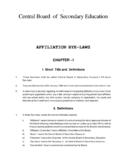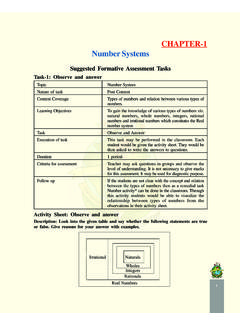Transcription of REPORT ON THE TRANSFER PRICING ASPECTS OF …
1 ORGANISATION FOR ECONOMIC CO-OPERATION AND DEVELOPMENT REPORT ON THE TRANSFER PRICING ASPECTS OF BUSINESS RESTRUCTURINGS chapter IX OF THE TRANSFER PRICING GUIDELINES 22 July 2010 CENTRE FOR TAX POLICY AND ADMINISTRATION FOREWORD This REPORT was approved by the Committee on Fiscal Affairs on 22 June 2010 and by the OECD Council on 22 July 2010. The Recommendation of the Council on the Determination of TRANSFER PRICING between Associated Enterprises [C(95)126/FINAL] was amended on 22 July 2010 to take account of the addition of the attached new chapter IX and concomitant revision of Chapters I-III of the OECD TRANSFER PRICING Guidelines for Multinational Enterprises and Tax Administrations.
2 2 TABLE OF CONTENTS chapter IX TRANSFER PRICING ASPECTS of Business Restructurings .. 4 Introduction .. 4 A. Scope .. 4 Business restructurings that are within the scope of this chapter .. 4 Issues that are within the scope of this chapter .. 5 B. Applying Article 9 of the OECD Model Tax Convention and these Guidelines to business restructurings: theoretical framework .. 5 Part I: Special considerations for risks .. 6 A. Introduction .. 6 B. Contractual terms .. 6 Whether the conduct of the associated enterprises conforms to the contractual allocation of risks.
3 7 Determining whether the allocation of risks in the controlled transaction is arm s length .. 7 What the consequences of the risk allocation are .. 12 C. Compliance issues .. 14 Part II: Arm s length compensation for the restructuring itself .. 15 A. Introduction .. 15 B. Understanding the restructuring itself .. 15 Identifying the restructuring transactions: functions, assets and risks before and after the restructuring .. 16 Understanding the business reasons for and the expected benefits from the restructuring, including the role of synergies .. 16 Other options realistically available to the parties.
4 17 C. Reallocation of profit potential as a result of a business restructuring .. 18 Profit potential .. 18 Reallocation of risks and profit 18 D. TRANSFER of something of value ( an asset or an ongoing concern) .. 20 Tangible assets .. 20 Intangible assets .. 22 TRANSFER of activity (ongoing concern) .. 25 Outsourcing .. 26 E. Indemnification of the restructured entity for the termination or substantial renegotiation of existing arrangements .. 26 Whether the arrangement that is terminated, non-renewed or 3 substantially renegotiated is formalised in writing and provides for an indemnification clause.
5 27 Whether the terms of the arrangement and the existence or non-existence of an indemnification clause or other type of guarantee (as well as the terms of such a clause where it exists) are arm s length .. 28 Whether indemnification rights are provided for by commercial legislation or case law .. 30 Whether at arm s length another party would have been willing to indemnify the one that suffers from the termination or re-negotiation of the agreement .. 30 Part III: Remuneration of post-restructuring controlled transactions .. 32 A. Business restructurings versus structuring.
6 32 General principle: no different application of the arm s length principle .. 32 Possible factual differences between situations that result from a restructuring and situations that were structured as such from the beginning .. 32 B. Application to business restructuring situations: selection and application of a TRANSFER PRICING method for the post-restructuring controlled transactions .. 34 C. Relationship between compensation for the restructuring and post-restructuring remuneration .. 35 D. Comparing the pre- and post-restructuring situations .. 36 E. Location savings.
7 37 F. Example: implementation of a central purchasing function .. 38 Part IV: Recognition of the actual transactions 40 A. Introduction .. 40 B. Transactions actually undertaken. Role of contractual terms. Relationship between paragraphs and other parts of these Guidelines .. 40 C. Application of paragraphs of these Guidelines to business restructuring situations .. 41 Non-recognition only in exceptional cases .. 41 Determining the economic substance of a transaction or arrangement .. 42 Determining whether arrangements would have been adopted by independent enterprises.
8 42 Determining whether a transaction or arrangement has an arm s length PRICING solution .. 43 Relevance of tax purpose .. 44 Consequences of non-recognition under paragraphs to .. 44 D. Examples .. 45 Example (A): Conversion of a full-fledged distributor into a risk-less distributor .. 45 Example (B): TRANSFER of valuable intangibles to a shell company .. 45 Example (C): TRANSFER of intangible that is recognised .. 46 4 chapter IX TRANSFER PRICING ASPECTS of Business Restructurings Introduction A. Scope Business restructurings that are within the scope of this chapter There is no legal or universally accepted definition of business restructuring.
9 In the context of this chapter , business restructuring is defined as the cross-border redeployment by a multinational enterprise of functions, assets and/or risks. A business restructuring may involve cross-border transfers of valuable intangibles, although this is not always the case. It may also or alternatively involve the termination or substantial renegotiation of existing arrangements. Business restructurings that are within the scope of this chapter primarily consist of internal reallocation of functions, assets and risks within an MNE, although relationships with third parties ( suppliers, sub-contractors, customers) may also be a reason for the restructuring and/or be affected by it.
10 Since the mid-90 s, business restructurings have often involved the centralisation of intangible assets and of risks with the profit potential attached to them. They have typically consisted of: Conversion of full-fledged distributors into limited-risk distributors or commissionnaires for a foreign associated enterprise that may operate as a principal, Conversion of full-fledged manufacturers into contract-manufacturers or toll-manufacturers for a foreign associated enterprise that may operate as a principal, Transfers of intangible property rights to a central entity ( a so-called IP company ) within the group.

















